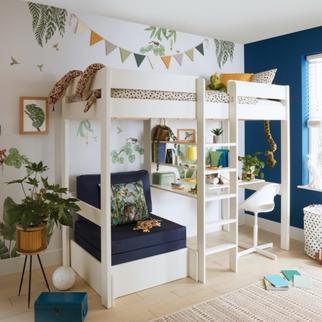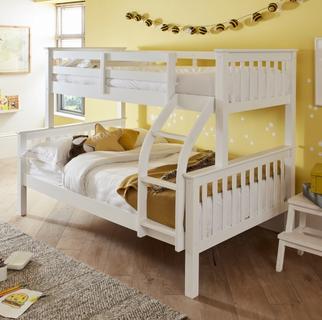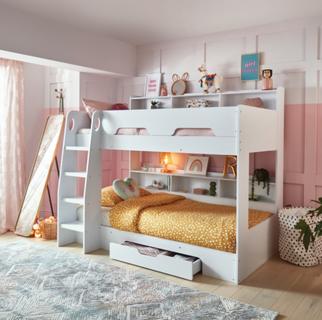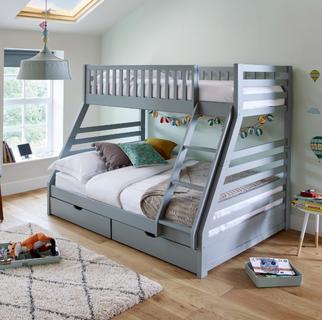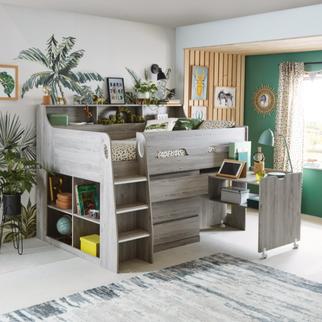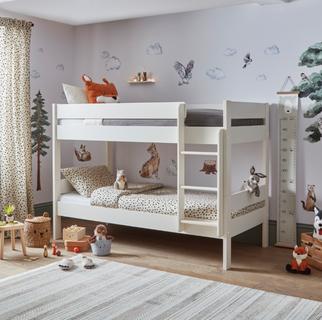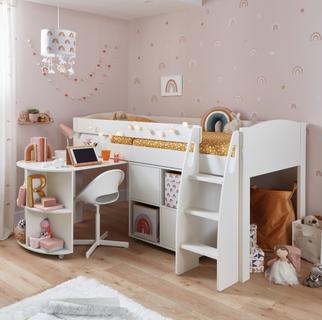
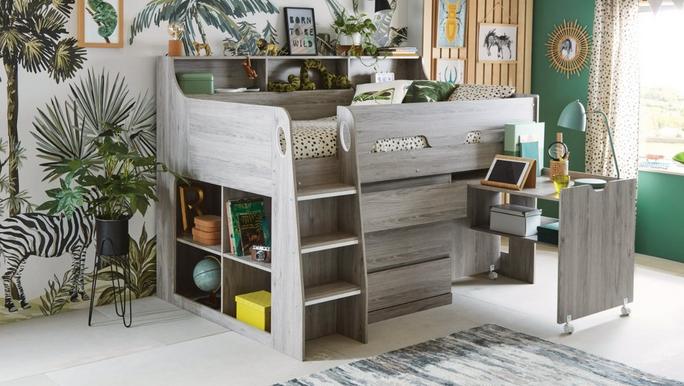
Much like with clothes, shoes, and toys, it can feel like a constant challenge to find the right bed for your growing child. One moment, their kid’s bed is the perfect size. The next, their feet are hanging over the footboard!
It’s not just the size of the bed that you need to consider though. It’s also important to pick out the right mattresses to support your little one’s posture throughout their different stages of development.
To help the transition from cot to toddler bed to ‘big kid’ single bed, we’ve created this kids’ bed buying guide. Take a look, below, to determine which type of kids’ bed is right for your home.

The cot-to-bed transition
One of the trickiest aspects of your little one growing up is knowing when to make that all-important transition from a cot to a bigger bed.
Typically, we’d recommend making the change to a toddler bed at two years old, but every child is different. Some may want to stay in a cot bed for longer, while others might be ready to make the change sooner.
Naturally, you should transition from a cot to a bed when you feel your child is ready to do so. Some of the cues parents should keep an eye out for include:
Climbing out of cots: This includes regularly attempting to climb out on a nightly basis, as well as successful escape attempts!
Complaining of aches or pains in bed: This may be due to either their mattress, bed, or both being too small for their growing frames.
A child talking about getting a bigger bed: The clearest and easiest sign is simply hearing that your child wants to upgrade their bed!
Beds and mattress sizes
Depending on how quickly your little one develops, you’ll likely need three to five different kids’ beds over the course of their childhood.
To choose the right bed at the right time, you need to consider the age of your child. Below, we’ve broken down the different sizes of beds and which ages they are suited to.
Cots
Standard dimensions: 120cm x 60cm (3ft 9” x 1ft 9”)
Keeping newborns safe and comfortable, cots and cribs will be the very first bed that your child will sleep in. To prevent your baby from rolling out of bed, the mattress is flanked on all sides by crib rails, which are typically adjustable. Best suited for children up to the age of 2.
Toddler beds
Standard dimensions: 140cm x 70cm (4ft 6” x 2ft 3”)
Otherwise known as cot beds, toddler beds are designed for children between the ages of 2 and 4. These small beds are usually low to the ground and, unlike cots, do not feature enclosing sides. Toddler beds are also often brightly coloured, distinguishing them from other standard kids’ beds.
Small single beds
Standard dimensions: 190cm x 76cm (6ft 3” x 2ft 6”)
Slightly shorter than standard single beds, small single beds are a great fit for children transitioning from a toddler bed in bedrooms strapped for space, usually around the age of 4. You can typically find small single mattresses on pull-out guest beds, bunk beds, and high sleeper beds.
Single beds
Standard dimensions: 190cm x 90cm (6ft 3” x 3ft)
The most common size of beds for children and adults alike, single beds are typically considered ‘big kid beds’ for children aged 4 and above. Single beds can comfortably fit into ‘box bedrooms’ as well as modest-sized kids rooms. Remember though, some kids’ beds, such as mid sleeper beds, can be a little longer and thus require a slightly bigger mattress to match.
For more assistance with finding the right bed and mattress size that’s right for you or your child, read our full bed and mattress size buying guide.
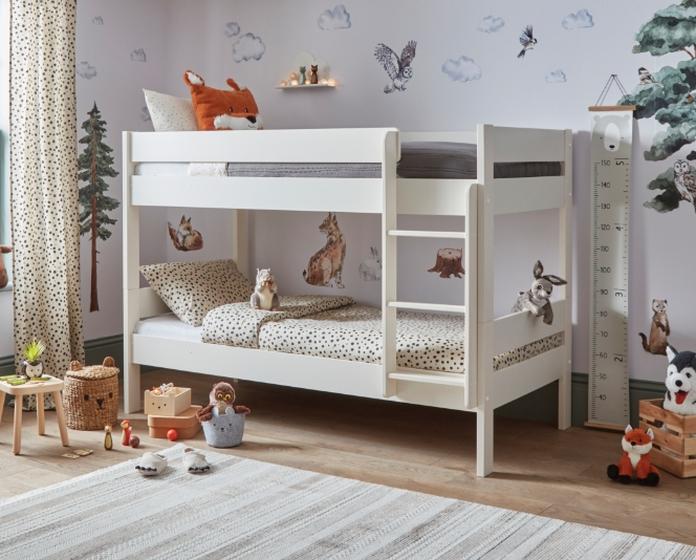
Kids’ beds
As you might expect, kids’ beds are smaller than a standard single, perfect for your little ones. In particular, our high sleepers and bunk beds make bedtime an exciting routine for younger children, whilst also saving on floorspace.
There are also triple sleeper bunk beds, which are perfect for sleepovers with friends and siblings who do everything together. Within our collection, we have Teo and Dual bunk beds, the latter of which offers built-in storage, too.
Take a look at our kids beds collection to see which type of bed might be best for your little one.
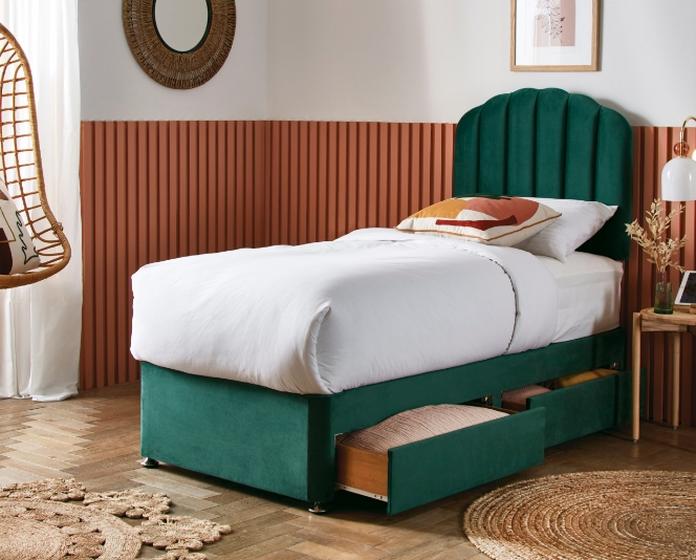
Single beds
With the smallest dimensions for a full-size bed, single beds are great choices for a variety of single sleepers. This includes children graduating from a kids’ bed, young teenagers, and adults sleeping on their own.
Their concise size also makes them a good fit for smaller spaces, such as box bedrooms, guest rooms, and studio apartments.
What are the different kid bed types?
Here at DFS, we understand that every child and home is different, meaning there is no one-size-fits-all solution. That’s why we offer many distinct kids’ bed types, to support your little ones throughout every stage of their childhood.
Cots
There are two types of cots that are designed to safely sleep children up to 4 years old.
The first is a standard cot or crib, which safely sleeps a newborn baby and their years developing into a toddler. A toddler bed is a smaller single bed with open sides and a low frame, keeping kids comfortable and offering a little more independence from 2 to 4 years old.
Single beds
Comfortably accommodating a solo sleeper, single beds are available in a variety of different designs that can fit into any size of bedroom. This type of bed is ideal for kids aged 4 and above.
There are also many different types of kids’ single beds to choose from, including trundle beds and kids’ beds with storage capacities. Of course, there are standard single beds that simply offer a classic bedframe, such as the subtle but stylish Thomson single bedframe.
Bunk beds
Perfect for bedrooms accommodating two children or for kids who frequently host sleepovers, bunk beds provide two beds in one. Bunk beds are safely designed with robust frames to handle the weight of an additional sleeper on a top bunk, so parents can rest assured that their little ones will be safe on either bunk.
The types of bunk beds for sale for sale at DFS include simple designs, such as the Stompa compact bunk bed. There are also bunk beds with different sized bases, like the Dual storage bunk bed, as well as bunk beds with shelves and drawers.
Mid sleepers
Mid sleepers, or cabin beds, are typically the same size as a single bed, just elevated higher off the ground. These sleeping spaces are guarded by a railing and are accessed by a safety ladder.
Kids’ cabin beds are often designed to make use of the same amount of floor space as a single bed whilst offering extra features. For example, mid sleepers with storage space are great for clearing away bedroom clutter, while mid sleepers with pull-out desks grant kids a place to draw and play, which is ideal when floorspace is at a premium.
High sleepers
High sleepers, otherwise known as loft beds, are bed frames that feature an elevated sleeping space. Beneath the frame is an open space, which is used for a variety of practical applications.
For example, there are high sleepers that include seating areas, desk space, or even a dedicated area for gaming, such as the Koda gaming bed. This provides kids with both somewhere comfy to sleep and a dedicated area for activities, all without taking up any more floor space in a bedroom.
Our bunk bed and high sleeper ranges
What mattress is right for my child?
Many of our kids’ beds, such as our bunk beds, come with mattresses that are the right fit for the bedframe. However, we understand that your child may require a specific type of mattress, whether they’re restless sleepers, are averse to warm nights, or you’re simply trying to discourage them from jumping on the bed.
To help you choose the right option, we’ve broken down the different types of mattresses and what benefits they provide to kids’ beds.
Traditional spring
Traditional spring mattresses, also known as open coil mattresses, feature large springs evenly spread out through the mattress, with layers of foam or natural padding for extra comfort and support. Open coil mattresses are great as kids mattresses as their firm design helps to support restless sleepers and kids who fidget throughout the night. They’re also more cost-effective than many other mattress types.
Open coil
Pocket sprung
Pocket sprung mattresses feature varying numbers of individually nested springs, each within separate pockets, which move independently and react to weight separately. This is opposed to open coil mattresses, which have larger springs that are spread out more widely and operate largely in tandem. Like open coil mattresses, pocket sprung mattresses are rated high for how supportive they are. They’re also well designed to isolate movements, which makes them even better for fidgeting kids.
Pocket sprung
Memory foam
Memory foam mattresses are designed with a supportive foam that contours to a sleeper’s body. Usually, memory foam mattresses are chosen to help relieve and support back and joint pain, though this may not be at the forefront of your priorities when selecting a kid’s mattress. However, this does make memory foam options very supportive mattresses, as well as rather firm. This means they’re great options for discouraging jumping on the bed. Memory foam mattresses also feature hypoallergenic properties, which makes them suitable choices for kids with allergies.
Memory foam
Gel and latex
There are also gel and latex-filled mattresses, which are often known as hybrid mattresses. Given the nature of hybrid mattresses, each design can be widely different, featuring open coil or pocket sprung designs as well as different types of filling within them. This means that they can feature the same benefits as other mattresses, depending on the type of springs within them. Mattresses with gel and latex fillings boast certain advantages, regardless of their designs. For example, gel mattresses are often much cooler than conventional mattresses, serving as great choices for kids who frequently complain of nights that are too warm. Latex also serves as a hypoallergenic option too, helping children with allergies sleep more soundly. For more help with choosing mattresses for every member of the family, check out our comprehensive mattress buying guide.
Hybrid
What else do I need to consider when buying a kid’s bed?
Even with all the information above, there are certain frequently asked questions about kids’ beds that can really help when choosing the right frame and mattress for your child.
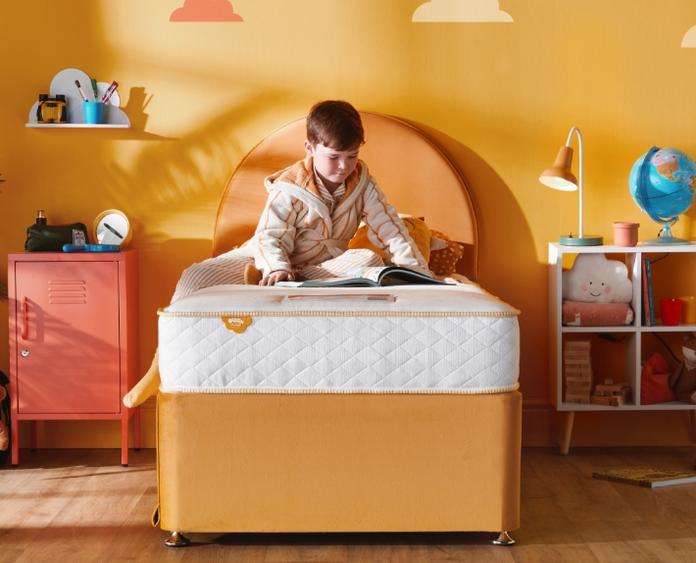
What mattress firmness is best for my child?
Whether you’re looking to properly support your little one throughout the night, limit any impact from fidgeting, or just want to discourage them from jumping on the bed, we’d recommend a medium-firm mattress. These mattresses tick off all these requirements, whilst still providing a comfortable night’s sleep.
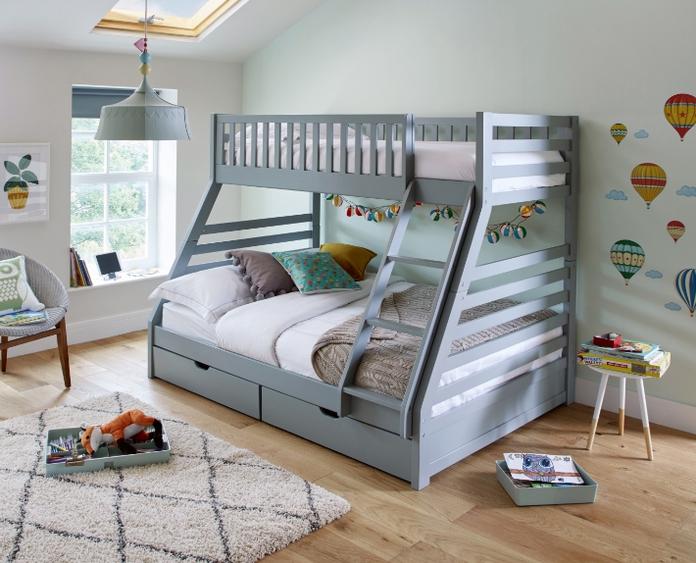
What mattress is good for bunk beds?
Many of our kids’ bunk beds are sold with mattresses that fit perfectly into each bunk, offering plenty of support and comfort.
When you’re looking for a mattress that’s good for kids’ bunk beds, you need to make sure that the mattress isn’t deeper than the side of the frame. For example, for a kids’ bunk bed, you need to ensure that the mattress doesn’t cover or go over the side safety rail.
However, if you’d like to opt for separate mattresses, some of the best options for bunk beds are medium-firm or firm mattresses. This is because the support they provide helps to maintain the integrity of a bedframe, both by discouraging bouncing on the bed and helping to absorb a sleeper’s weight.

What if my child frequently has sleepovers?
If you’re expecting more than one sleeper in your child’s bedroom, we’d highly recommend bunk beds. From single bunk beds to double bunk beds, these kids’ beds provide sleeping spaces for multiple kids, without taking up more square footage than a single bed frame.
Of course, you can also choose a trundle bed, as the pull-out sleeping space can comfortably accommodate a smaller guest sleeper.
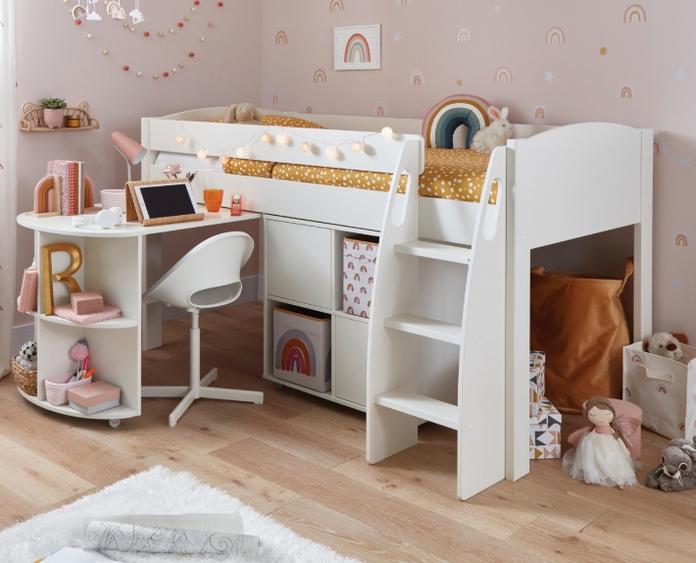
Should I consider kids’ beds with additional features?
Some of the most useful additions to a kid’s bed are extra storage solutions or even additional sleeping spaces. This includes children’s single beds with pull-out drawers or shelving areas, kids bunk beds, and single beds with trundles.
These additions don’t impact the safety or comfort of a kid’s bed but provide plenty of extra storage space to help declutter a kid’s room. Or they grant extra sleeping spaces, without imposing on the available floor space of a bedroom.

What if my child wets the bed?
Accidents can happen throughout the night, but luckily you can be prepared to handle them. A washable mattress protector helps to protect the bed and the mattress, as do washable bed pads. By using these, you can ensure that the mattress beneath stays protected and lasts beyond any bed wetting phases.
With the help of our buying guide, you should be ready to find the perfect kids’ bed for your little ones. Head over to our kid’s beds page, or our beds and mattresses page, to find your kid’s dream bed and make bedtime happier for everyone!
